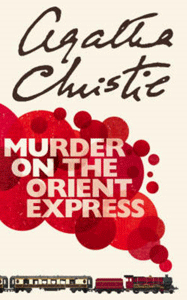If Hercule Poirot could design his own mystery to solve, it would be “Murder on the Orient Express” (1934). Because the train is stuck in a snowdrift in the Yugoslavian mountains, he has a captive set of interviewees and he can take his time solving this case.
A lot to think about
Separated into three parts, Agatha Christie’s classic includes a part titled “Hercule Poirot Sits Back and Thinks.” The man is in his element like never before or since, with no phone calls or summonses to distract him; he’s running the show. And even though it’s a challenging case with a solution unlike any other, he also gets to show off here.
His impromptu pair of Hastings stand-ins, train company manager Bouc and Dr. Constantine, are continually amazed, particularly with how Poirot bravely makes guesses amid interviews and immediately gets an answer.

“Murder on the Orient Express” (1934)
Also published as: “Murder in the Calais Coach”
Author: Agatha Christie
Genre: Mystery
Series: Hercule Poirot No. 9
Setting: 1934, train stuck in snowdrift in Yugoslavia
On page 178, Poirot correctly guesses the identity of Mary Debenham:
“Mon cher, vous etes epatant!” (Bouc) cried. “Another miraculous guess.”
“It is incredible how you think of these things,” said Dr. Constantine admirably.
And in the famous finale, he gets to strut his stuff before all 12 passengers of the Calais Coach (excepting the stabbed-to-death Ratchett). This ranks as one of the most thrilling Christie finales, as Poirot spells out two theories of the crime. (SPOILERS FOLLOW.)
In Theory No. 1, someone snuck onto the train at a station, killed Ratchett and snuck off. In Theory No. 2, all 12 passengers – all wanting revenge for the Armstrong Kidnapping Case — conspired to kill Ratchett and afterward spun a web of lies to keep the sleuths confused.
We know the latter is correct, but Bouc and Constantine – going extra-judicial along with Poirot – agree that the first theory could be correct.
He is the law
It’s not the first time Poirot embraces a non-legal type of justice, but it’s the most empathetic instance. Compare this, for example, to how he is fine with murderers’ suicides in “The Murder of Roger Ackroyd” and “Peril at End House.”
Christie masterfully ends the book at the very moment the decision is made by Poirot, Bouc and Constantine. Indeed, there’s little fat in “Orient Express.” It’s almost entirely a procedural, with 12 straight chapters titled “The Evidence of …” and then the interviewee’s name.
Yet it’s not a dry procedural. This is one of Christie’s best character novels. The ethnic and class variety – and distinctive personalities — among the dramatis personae is remarkable. Poirot notes that such a melting pot of types only occurs on trains and in America (thus giving him a clue).

Christie – often amused by the stereotypical and ridiculous ways people behave — shows unusually straightforward sympathy for these people. The Armstrong Kidnapping Case isn’t merely a backstory and motive, it’s a weighty tragedy.
Which isn’t to say the novel is never funny. In that chapter where Poirot sits back and thinks, he encourages his two colleagues to do the same. While Poirot makes breakthroughs via his grey cells, Bouc’s thoughts go in circles and Constantine’s drift toward the mistress his wife doesn’t know about. It’s laugh-out-loud funny.
Order, method … and explanations thereof
Is “Orient Express” perfect? Well, I can nitpick. If Poirot didn’t happen to know about the Armstrong case in detail, he’d be out of luck in this day before Wikipedia. But he has been established as a voracious newspaper reader.
Besides, if every novel is allowed one big coincidence, I’m happy that Poirot’s presence is it – especially since he’s at the top of his game. “Orient Express” could be a handbook, as every step of the way Poirot explains his order and method to Bouc and Constantine (and us).
In addition to Poirot’s method of “guessing” and having people automatically confirm or deny the guess, I’m impressed, for example, by how he analyzes Cyrus Hardman. The man says he’s an undercover American detective. Poirot has no way to check on this until he’s back amid civilization. But he uses a logic sequence to determine it’s more likely Hardman is telling the truth than lying.
Christie also finds space to give “Orient Express” a sense of place. Although it’s set on a train – making for a “closed-room” mystery that can be adapted to the screen on a reasonable budget – the book has a chilliness that’s not accidental.
Passengers disembark at stations to stretch their legs but then quickly return to the train because it’s freezing outside. Despite Christie’s warm feelings for her characters, revenge is a dish best served cold – and it is served to Ratchett thusly (and violently). “Murder on the Orient Express” is a stone-cold classic.
Sleuthing Sunday reviews an Agatha Christie book or adaptation. Click here to visit our Agatha Christie Zone.

